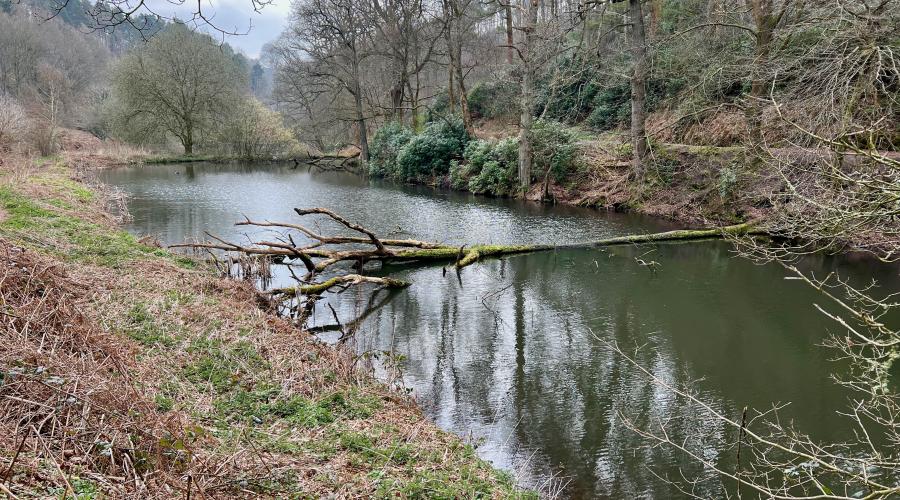Churnet Valley, Staffordshire's Little Switzerland
22 people attending
8 places left
This is a fairly easy walk through Dimmingsdale Valley and Churnet Valley, known as Staffordshire's Rhineland or Little Switzerland.
The River Churnet is a tributary of the River Dove in Staffordshire. It flows through the Staffordshire moorlands, then passes through Tittesworth Reservoir and Leek. The river was heavily influenced by industry for nearly a thousand years and, used for dye production in the 18th and 19th centuries, it became one of the most polluted rivers in Europe. Throughout Churnet Valley there are steep gorges and banks, with an abundance of woodland and Wildlife, and several woods are owned by the National Trust and the RSPB. The quality of the water has improved after the decline of industry, and a program to reintroduce salmon is underway.
Alton Towers first opened to the public on a regular basis following the opening of Alton Towers railway station in 1849. You can hear the roller coasters in the theme park en route and there is a view of Alton Mansion, owned by the Earls of Shrewsbury, upon which Alton Towers was built. Money raised from railway excursions was paid to the earl and helped to maintain the upkeep of the grounds. We walk past the station that was closed in 1965.
There is also a view of Alton Castle, in a Gothic-revival style designed by A W Pugin, constructed in the mid-19th century by John Talbot, 16th Earl of Shrewsbury. It is a designated a Grade I listed building and scheduled ancient monument, and it is now being used as a Catholic Youth Retreat Centre.
Total distance 12 km (7.5 miles). Total ascent 232 m (761 feet). Approximately 5 hours (including pub stop).
Dogs
Well behaved dogs are welcome but owners must ensure dogs are kept under control at all times. The pub is dog friendly.
IMPORTANT! - Participation Statement
You MUST complete a Participation Statement, in addition to booking your event space before attending an OutdoorLads event. You only need to complete this Participation Statement once, not for each event you attend.
All images taken by the event leader with permission for ODL use.
















What to bring
Please keep an eye on the forecast and be prepared for cold or wet weather if necessary.
For anyone unfamiliar with walking, here is a standard kit-list you may wish to draw from:
Suitable well-fitted walking footwear is most important to keep you safe and comfortable. Sturdy trainers with cushioned soles and a good grip are often suitable but proper walking boots or shoes in wet conditions or on uneven ground are preferable. Smooth soles with no grip are not suitable. Thick, well-fitted socks cushion your feet, help to keep you dry, and prevent blisters.
Layers of clothing you can easily put on and take off according to changing temperature and weather conditions help to keep you warm and comfortable. Choose a base layer (vest or t-shirt), a mid layer (micro-fleece or long-sleeved shirt), and in cooler weather add an outer layer (windproof jacket or thick fleece). Breathable fabrics are more comfortable and dry more quickly. Synthetic trousers are lighter and dry quicker than denim. Large pockets are useful.
Avoid jeans as they become heavy and cold in the rain, and take ages to dry out. On warm days shorts may be suitable, but consider rough foliage such as brambles or nettles on some routes. Check for ticks when walking through long grass, etc. with bare legs.
A hat or cap keeps your head and eyes shaded in direct sun. Sunglasses protect your eyes from glare and make it easier to see where you are going. Sun block is advisable during prolonged exposure. In colder weather or a biting wind, a hat, scarf and gloves are essential.
Bring waterproofs to stay dry in wet weather. Water resistant fabric loses effectiveness over time. It will need to be re-proofed or replaced periodically. Bring a towel and a set of dry clothes to change into if possible. A backpack rain cover helps to keep belongings dry. Gaiters are optional and help to keep lower legs and feet dry. An umbrella is impractical while walking.
A comfortable backpack of 20 to 30-litre capacity, allowing you to use your arms freely, is suitable for most day walks.
Walking sticks are optional and may assist when climbing or descending, or on uneven ground.
Bring any essential medicine you may need during the day for hay-fever, diabetes, or any on-going ailments or conditions.
For further information see https://www.outdoorlads.com/my-first-walking-event
Food & drink
Bring plenty of water and any preferred drinks, food and snacks to keep you going during the day.
Bring a packed lunch to eat about half way through the walk.
There will be a pub stop about 2/3 of the way through the walk. The pub is dog friendly.